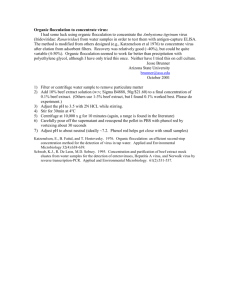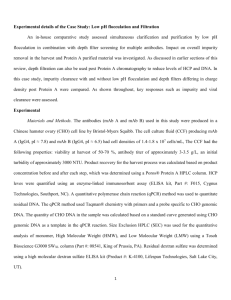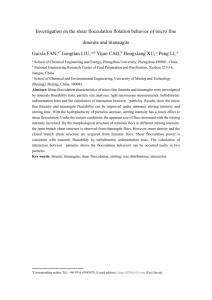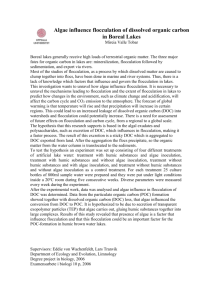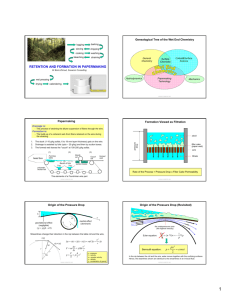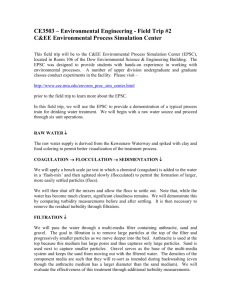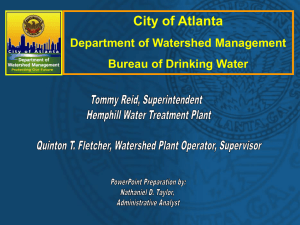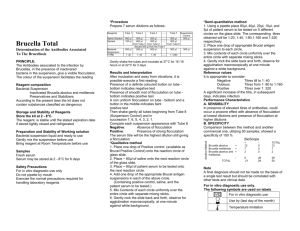flocculation and flocculation filtration
advertisement
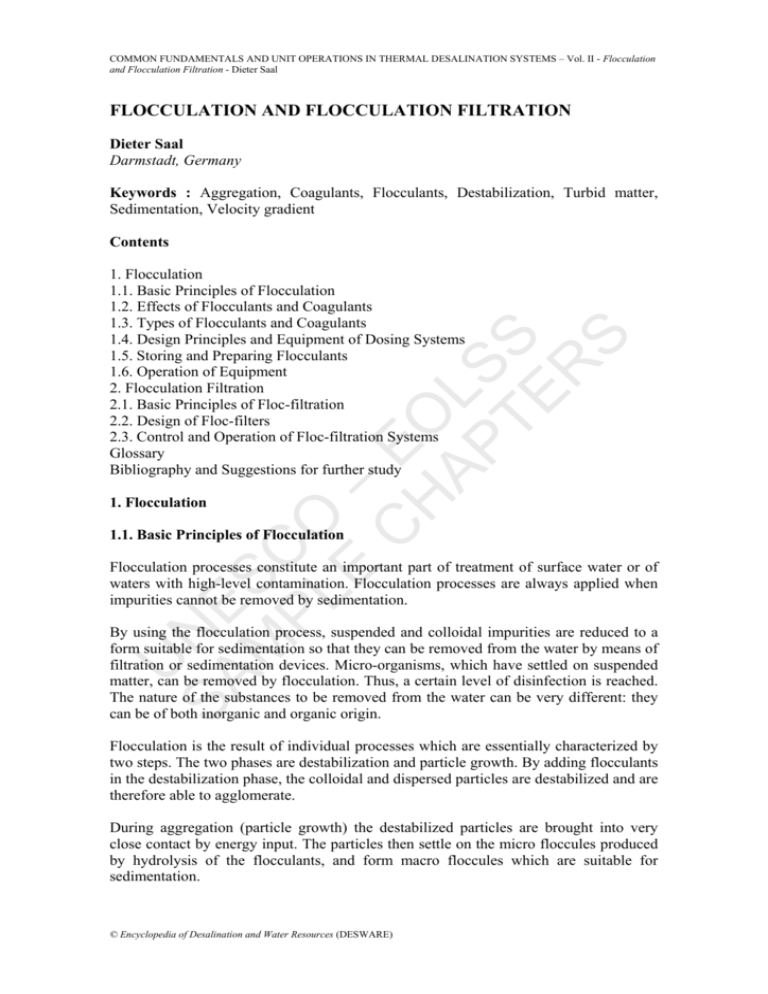
COMMON FUNDAMENTALS AND UNIT OPERATIONS IN THERMAL DESALINATION SYSTEMS – Vol. II - Flocculation and Flocculation Filtration - Dieter Saal FLOCCULATION AND FLOCCULATION FILTRATION Dieter Saal Darmstadt, Germany Keywords : Aggregation, Coagulants, Flocculants, Destabilization, Turbid matter, Sedimentation, Velocity gradient Contents U SA NE M SC PL O E – C EO H AP LS TE S R S 1. Flocculation 1.1. Basic Principles of Flocculation 1.2. Effects of Flocculants and Coagulants 1.3. Types of Flocculants and Coagulants 1.4. Design Principles and Equipment of Dosing Systems 1.5. Storing and Preparing Flocculants 1.6. Operation of Equipment 2. Flocculation Filtration 2.1. Basic Principles of Floc-filtration 2.2. Design of Floc-filters 2.3. Control and Operation of Floc-filtration Systems Glossary Bibliography and Suggestions for further study 1. Flocculation 1.1. Basic Principles of Flocculation Flocculation processes constitute an important part of treatment of surface water or of waters with high-level contamination. Flocculation processes are always applied when impurities cannot be removed by sedimentation. By using the flocculation process, suspended and colloidal impurities are reduced to a form suitable for sedimentation so that they can be removed from the water by means of filtration or sedimentation devices. Micro-organisms, which have settled on suspended matter, can be removed by flocculation. Thus, a certain level of disinfection is reached. The nature of the substances to be removed from the water can be very different: they can be of both inorganic and organic origin. Flocculation is the result of individual processes which are essentially characterized by two steps. The two phases are destabilization and particle growth. By adding flocculants in the destabilization phase, the colloidal and dispersed particles are destabilized and are therefore able to agglomerate. During aggregation (particle growth) the destabilized particles are brought into very close contact by energy input. The particles then settle on the micro floccules produced by hydrolysis of the flocculants, and form macro floccules which are suitable for sedimentation. © Encyclopedia of Desalination and Water Resources (DESWARE) COMMON FUNDAMENTALS AND UNIT OPERATIONS IN THERMAL DESALINATION SYSTEMS – Vol. II - Flocculation and Flocculation Filtration - Dieter Saal According to the origin of the water to be cleaned, the composition of the dispersed substances in the water can be very different. The substances can be of mineral or organic origin. Problems in the treatment of such waters can arise when the type and composition of the dispersed particles change very rapidly. Organic matter such as algae, bacteria, or plankton can have the same influence since their sedimentation qualities vary enormously owing to their different proportion of sizes and solids closeness to mineral colloids. The surfaces of dispersed particles are also surrounded by molecules, which do not lead to an aggregation of the particles since several stabilizing forces have a counteracting effect. The causes can be: Electrostatic rejection with homogeneous particle charge; Hydration; Stabilization through higher molecular interfacial activity. U SA NE M SC PL O E – C EO H AP LS TE S R S • • • In practice these mechanisms very often overlap. In waters containing suspended matter, the impurities consist almost exclusively of negatively charged particles. Therefore, as a result of this charging process, they are stable with regard to aggregation of the particles. If this stable condition is to be canceled, the influencing forces counteracting an aggregation must be reduced by adding suitable flocculation chemicals which make agglomeration effective. The water-treatment technique uses aluminum and iron salts for flocculation, i.e. for destabilization. These salts are mainly added in a dissolved form. During the process of flocculant metering the flocculants cover a pH-range of the water to be cleaned. The pH-value ranges from a very low acid value, with the flocculants in solution form, to basic values. Hydroxides are produced as voluminous, extremely watery floccules. As a result of flocculant metering and with increased dosage, compensation of the negative charge of the particles takes place and produces optimum destabilization. A further increase in the flocculant dosage, exceeding the optimum amount, can lead to a reversal of the charge, which in turn restores stabilization. Only small concentrations of flocculants are necessary for destabilization. However, a certain stoichiometrical relationship must exist between particle concentration and the required flocculant dosage. Destabilization can be effected by adsorption with charge neutralization using positively charged metal hydroxide complexes and highly charged cation polymer. If the amount of added hydrolyzing salts, such as aluminum or iron (III) salts, considerably exceeds solubility of the hydroids, the inclusion of the dispersed particles will cancel out the hydroids and produce a precipitation effect. This coprecipitation effect is dominant when there are high concentrations of flocculants and high pHvalues. The hydroxides canceled out by exceeding solubility, precipitate both in the water and on the surface of the dispersed particles. They settle and form large, extremely hydrous floccules. The two most important reaction stages describing the flocculation process are destabilization and transport/aggregation. Destabilization, the first stage of flocculation after adding flocculants, is of particular © Encyclopedia of Desalination and Water Resources (DESWARE) COMMON FUNDAMENTALS AND UNIT OPERATIONS IN THERMAL DESALINATION SYSTEMS – Vol. II - Flocculation and Flocculation Filtration - Dieter Saal importance with regard to the result of flocculation. Errors or processing faults, preventing the destabilization process from running optimally, are difficult to rectify totally in the next processing stage. Adequate energy input produces turbulence which both in turn determine the effectiveness of the flocculation process. In the first stage the flocculant solution, which is very small in proportion to the quantity of water to be treated, is applied to the turbulent water. The speed of the mixing operation is boosted by a mechanical mixing device of which there are different designs. Under the conditions customary in water treatment, the collision frequency plays a dominant part due to the velocity gradients. This is referred to as orthokinetic flocculation (Hahn 1985; Jekel 1985; Axt 1967). The mean velocity gradient G is the measurement for the energy input as a result of agitation or intended pressure losses. U SA NE M SC PL O E – C EO H AP LS TE S R S With regard to flocculation reactors with energy input as a result of agitation, the velocity gradient is ascertained by the output of the agitator motor. G = P (s −1 ) = P (η V0 ) −1 η V0 (1) In the mixing or destabilizing stage of water treatment, the G value in the range of 500 to 1500 s-1 has proved in practice to be the most effective. The necessary energy input for this is approx. 100-200 W per m3 reaction volume according to the effectiveness of reaction, (Hahn 1985; Stumm 1967; Kawamura 1996). For water treatment a range of G t from 10,000 to 150,000 has been recommended for optimum flocculation. Upon completion of the destabilization process, the phase of particle aggregation begins in which the velocity gradient gains more significance with a particle diameter of > 1 μm. An increase in the shearing gradient leads to more rapid coagulation. However, oversize floccules do not withstand the shearing stress. As a result, the size of the floccule decreases as the G value increases. By applying process technology, the solution is to allow micro floccules to be produced in a short time using high G values. In the following stage floccules of a suitable mean size are as a rule produced in separate containers by applying lower G values (30-80 s-1). The shearing resistance of the floccules is increased by metering the polymer flocculants. The macro floccules, produced by means of polymers, cannot be reproduced once they are destroyed. For this reason it is important to ensure careful transport of the macro floccules. In addition to the velocity gradient already described, the pH-value also constitutes an important contributory factor with regard to the effectiveness of flocculation. It is also important to note that the various flocculants require different pH-values. For flocculation using aluminum sulfate the most favorable pH-value is between 5.5 and 7.0. A higher pH-range is used for flocculation with ferric chloride or ferric sulfate, allowing good coagulation. The optimum range in this case is between pH 6.5 and 7.8. Iron salts can be used with higher pH-values of max. 9.5, such as plants for decarbonization. This process, however, is now referred to as precipitation and not as flocculation. The water temperature also has an influence on the flocculation quality. Flocculation at temperatures lower than 5 degrees is highly ineffective and requires accurate adaptation of the flocculation conditions. In addition to an extended © Encyclopedia of Desalination and Water Resources (DESWARE) COMMON FUNDAMENTALS AND UNIT OPERATIONS IN THERMAL DESALINATION SYSTEMS – Vol. II - Flocculation and Flocculation Filtration - Dieter Saal reaction time and agglomeration phase, the pH-value must be corrected. Once the optimum pH-value has been adapted to the given temperature, it is generally not necessary to increase the metering rate. 1.2. Effects of Flocculants and Coagulants U SA NE M SC PL O E – C EO H AP LS TE S R S The object of applying the flocculation technique for water treatment is to achieve the highest possible cleaning effect. The flocculation conditions for this purpose are set by selecting the type and quantity of flocculants as well as the optimum pH-value. It is important to optimize the parameters so that the floccules develop favorable qualities for the subsequent separating process. A sufficient amount of deflocculated impurities must also be integrated into the floccules and removed. To produce the desired floccule quality there are several possibilities, such as flocculation times, energy input, quantity of flocculants, type of flocculant, optimization of the pH-value, and the use of flocculation aids. In order to synchronize coagulation to the subsequent separation process, it is necessary to have specialized knowledge of the individual processes as well as of the influence of every single stage. The qualities of the floccules are characterized by their size, size distribution, and density. The following separation processes can be applied in practice: • • • • Sedimentation using different systems; Sedimentation and subsequent filtration; Filtration without prior sedimentation; Flotation with and without filtration. These techniques will be given closer consideration in a later section. The effect of both flocculation and coagulation is influenced by organic and inorganic matter in the water to be treated. The dissolved organic substances, regardless of origin, clearly have an influence on the flocculation process. This is due to the adsorption of floccules and to the complex reactions, which restrict the effectiveness of the added flocculants and can lead to an increase in the demand for flocculation aids. Alternatively, it is also possible to considerably reduce the humic matter in water by optimizing the flocculation process with the use of flocculants. However, the elimination of synthetic organic substances by flocculation has only been successful to a varying degree. Elimination or reduction requires specialized knowledge of these substances; alternatively flocculation tests can be carried out. Inorganic impurities or harmful substances contained in the water, such as phosphate, can easily be removed since they are bound in the hydroxide floccules. - TO ACCESS ALL THE 16 PAGES OF THIS CHAPTER, Visit: http://www.desware.net/DESWARE-SampleAllChapter.aspx © Encyclopedia of Desalination and Water Resources (DESWARE) COMMON FUNDAMENTALS AND UNIT OPERATIONS IN THERMAL DESALINATION SYSTEMS – Vol. II - Flocculation and Flocculation Filtration - Dieter Saal Bibliography and Suggestions for further study Axt G (1967) Chemische Vorgang bei der Flockung, Universitat karlsruhe, Veroffentlichung Lehrstuhl, Wasserchemie. Haberer K, Merkl G, Grombach P and Trueb E U (1993) Handbuch der Wasserversorgungstechnik, R Oldenburg Verlag Munchen. Hahn H H (1985) Entstabilisierungs-und Agglomerationsvorgange DVGW - Schriftenreihe Flockung. Herzig J P, Leclerc D M and Goff P (1970) Flow of suspensions through porous-media-application to deep filtration. Industrial and Engineering Chemistry 62(5), 8-35. Jekel M (1985) Die Flockung in der wasseraufbere DVGW - Schriftenreihe Flockung. Kawarnura S (1996) Optimisation of basic water-treatment processes, design and operation, coagulation and flocculation, AQUA 45(1), 35-47. U SA NE M SC PL O E – C EO H AP LS TE S R S Matisui Y (1995) Simulation of deep filter performance for optimum design, AQUA 44, 245-257. Saal D and Warwel M (1981) Untersuchungen zur Verbesserung der Filtratqualitat bei Mehrschichtfiltern 2, 52-54. Sontheimer H (1971) Flockungsfiltration, Universitat Karlsruhe, Veroffentlichung Lehrstuhl fur Wasserchemie - Filtration 159-182. Stumm W (1967) Regelwerk Wasseraufbereitung , Technische Mitteilung, Merkblatt W 217. Treweek G P (1979) Optimization of flocculation time prior to direct filtration, AWWA 96-101. Willson R, Lekkas Th D and Fox G T J (1980) Orthokinetic flocculation time in deep bed granular water filters, AWWA, 356-366. © Encyclopedia of Desalination and Water Resources (DESWARE)
